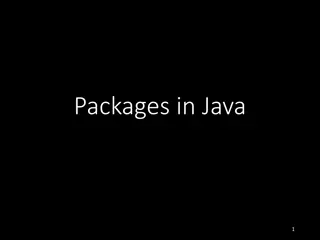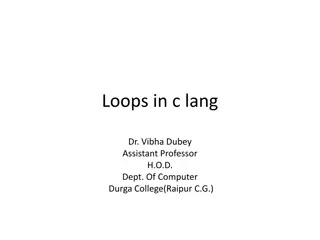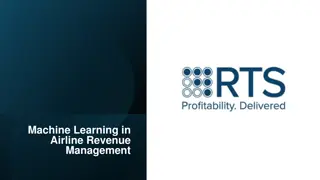
Analysis of Programming Languages and Operating Systems
"Explore the intricacies of programming languages and operating systems, covering topics such as machine language, regular expressions, process execution modes, and reasons for process termination. Gain insight into the major requirements and modes of execution in operating systems. Understand when and why a process switches, and delve into the evaluation and testing of programming languages. Dive into the world of software development and system management with this comprehensive analysis."
Download Presentation

Please find below an Image/Link to download the presentation.
The content on the website is provided AS IS for your information and personal use only. It may not be sold, licensed, or shared on other websites without obtaining consent from the author. If you encounter any issues during the download, it is possible that the publisher has removed the file from their server.
You are allowed to download the files provided on this website for personal or commercial use, subject to the condition that they are used lawfully. All files are the property of their respective owners.
The content on the website is provided AS IS for your information and personal use only. It may not be sold, licensed, or shared on other websites without obtaining consent from the author.
E N D
Presentation Transcript
Analysis of Programming Language Vladimir Viies vladimir.viies@gmail.com, Lembit J rim gi lembit.jyrimagi@gmail.com Tallinna Tehnika likool 2017
Course timetable(new) 1. 2. 3. 4. 5. 6. 7. 8. 9. 10. 08.11.2018 11. 15.11.2018 12. 22.11.2018 13. 29.11.2018 14. 06.12.2018 15. 13.12.2018 16. 20.12.2018 06.09.2018 13.09.2018 20.09.2018 27.09.2018 04.10.2018 11.10.2018 18.10.2018 25.10.2018 01.11.2018 Introduction Machine Language, Assembly Language Regular Languages, Regular Expressions, Flex Context Free Grammar, Bison, Postfix/Infix Calculator Practice Task 1 Abstract Syntax Tree, General Purpose Language General Purpose Language 2 Guest lecturer 1 Guest lecturer 2 + seminar/practice task Guest lecture 3 +seminar/practice task Evalution of Programming language/Test Functional Language /Practice Task 2A Practice Task 2B / Consultation Seminar Seminar/Exam Exam 3
Points (EXAM & PERMISSION) Practice(T1+T2) ----max20p Homework(translator) ----max15p Presentation(languages)---max10p Seminar max5p Written examination--max50p Permission to examination(30p) min 10pract(max20) +min 20test (max 30) 4
Major Requirements of an Operating System Interleave the execution of several processes to maximize processor utilization while providing reasonable response time Allocate resources to processes Support interprocess communication and user creation of processes
Modes of Execution User mode Less-privileged mode User programs typically execute in this mode System mode, control mode, or kernel mode More-privileged mode Kernel of the operating system
Reasons for Process Termination I/O failure Invalid instruction happens when try to execute data Privileged instruction Data misuse Operating system intervention such as when deadlock occurs Parent terminates so child processes terminate Parent request
When to Switch a Process Clock interrupt process has executed for the maximum allowable time slice I/O interrupt Memory fault memory address is in virtual memory so it must be brought into main memory
State Instructions- represent state transition via program execution You have a choice: implement with hardware, (quick yet inflexible) You have a choice: implement with software, (slow and flexible) 11
Memory Tables Allocation of main memory to processes Allocation of secondary memory to processes Protection attributes for access to shared memory regions Information needed to manage virtual memory
File Concept Contiguous logical address space Types: Data - numeric - character - binary Program
File Attributes Name only information kept in human- readable form Identifier unique tag (number) identifies file within file system Type needed for systems that support different types Location pointer to file location on device Size current file size Protection controls who can do reading, writing, executing Time, date, and user identification data for protection, security, and usage monitoring Information about files are kept in the directory
File Structure None - sequence of words, bytes Simple record structure Lines Fixed length Variable length Complex Structures Formatted document Relocatable load file Can simulate last two with first method by inserting appropriate control characters Who decides: Operating system Program
Operations Performed on Directory Search for a file Create a file Delete a file List a directory Rename a file Traverse the file system
Access Methods Sequential Access Direct Access n = relative block number read next write next reset no read after last write (rewrite) read n write n position to n rewrite n read next write next
File Operations File is an abstract data type Create Write Read Reposition within file Delete Truncate Open(Fi) search the directory structure on disk for entry Fi, and move the content of entry to memory Close (Fi) move the content of entry Fi in memory to directory structure on disk
Open File Locking Mandatory or advisory: Mandatory access is denied depending on locks held and requested Advisory processes can find status of locks and decide what to do
Open Files Several pieces of data are needed to manage open files: File pointer: pointer to last read/write location, per process that has the file open File-open count: counter of number of times a file is open to allow removal of data from open-file table when last processes closes it Disk location of the file: cache of data access information Access rights: per-process access mode information
Evaluation of program language Efficient translation Efficient execution Writeability Simplicity- all features of the language should be easy to learn and master Expressiveness Definiteness Readability Reliability- static and dynamic checking Static during compile Dynamic during execution 24
Language evalution A Expressivity- readability Well defined- syntax, semantics I/O facilities Portability Efficiency Pedagogy- easy to teach & learn Generality- useful in wide range of applications 25
Language evalution B Readability : - - - - - Simplicity Orthogonality Control statements Data structures Syntax 26
Language evalution C Writeability: - Simplicity - Orthogonality - Support for abstraction Reliability: - Type checking - Exception handling - Readability/ writeability - Aliasing 2 different ways to refer to the same spot in memory/storage 27
Language evalution D Cost: - - - - - Training Code development Compilation Execution Maintenance 28
ESSENTIAL CHARACTERISTICS Well defined syntactic and semantic definition of language Reliability Fast translation Efficient object code Orthogonality Machine independence 29
DESIRABLE CHARACTERISTICS Provability Generality Consistency with commonly used notations Subsets Uniformity Extensibility (ease to add features) 30
Significant Language Features I Simple to learn Machine Independent More natural ways to express mathematical functions Problem orientated language Remains close to and exploits the available hardware Efficient execution Ability to control storage allocation More freedom in code layout 31
Significant Language Features II Loops Input from the keyboard Menu Driven Applications System Commands Structured Programming Subroutines Built-In Functions User-Defined Functions Arrays, sorting, and searches 32
Language design I A: Focus on one well known feature at a time, (could be basic as data Examine many alternative features designed by others & choose the best, rejecting those that are inconsisten type) 33
Language design II B: Choose specific application (logic, financial, etc.) Keep design committee small Choose precise design goals Release versions to small sets of interested people Revise language definition Attempt to build compiler & write formal language definition-semantics Produce clear and concise manual Provide "production quality" compiler and wide distribution Write primers explaining language 34
Language design III Release versions to small sets of interested people Revise language definition Attempt to build & write formal language definition- semantics Revise language definition Produce clear and concise manual Provide "production quality" compiler and wide distribution Write primers explaining language 35
COMPUTER AS A MULTI-LEVEL MACHINE Each level supported by the level below it! level 5 => problem oriented language translated (by compiler) level 4 =>assembly language level (translated by assembly) level 3 =>operating system (partial interpretation by OS) level 2 =>conventional machine language( interpreted by micro program) level 1 =>micro-programming ( directly executed by hardware) level 0 =>digital logic (gates & transistors program address registers) 37
Interpreter Fetch op code De-code op code Fetch necessary operands Branch to primitive (OPk) Then repeat until the end of the program 38
TRANSLATION VS. INTERPRETATION I Translation: program written for level n machine translated to level 1 machine Advantages: -statements decoded ONCE - efficient execution Disadvantages: -space consumption Interpretation: program written for level n + 1 is executed on level n machine Advantages: -space conservation Disadvantages: -execution 39
TRANSLATION VS. INTERPRETATION II TRANSLATORS Compiler: high level-> machine Assembler: one to one, assembly -> machine Loader: relocatable version of machine code - > machine code Link editor: combines collections of relocatable programs -> single relocatable machine program Pre-processor: extended language -> standard language 40
TRANSLATION VS. INTERPRETATION III INTERPRETER Fetch op code De-code op code Fetch necessary operands Branch to primitive (OPk) Then repeat until the end of the program 41
SQL Translator Make up a language for specific area or task of your choice. An example and a possible choice is a language for managing library. Create a SQL translator using GNU Bison (or any alternative) to translate your made up language to SQL. Write a simple database interface for executing the translated SQL queries in a database. Set up a simple database to demostrate inserting and quering data in the made up language
Fortran Compiler completed 1957 Mostly using assembly languages Fortran 1 & 2 designed while the Fortran 0 compiler was in development stage 1960 Fortran IV Fixed fields in source code (columns 1-5 labels, 6 'continue', 7-72 source, 73-80 sequence fields) Implicit typing (I-N was integer variable types, all else was floating point) Arithmetic 'if' , q , (>0, <0, =0) 'Do' iterator Formatted i/o Comments 43
1963 Naur developed Algol 60 ('root' for Pascal, PL/1, Ada) 'Free' format (freedom of indentation, spacing, etc) Reserved words (certain words could not be variable names) Explicit typing (variable type had to be explicitly defined) General iterator (similar to 'while') Block structure Recursive procedures Dynamic array bounds Value parameters 44
What is an "Algol-like" language? Algorithmic language for describing Processes Imperative (most computation work done in assignment statements) Block & procedure Lexical scope C Algol lexical scope 45
An "Algol-like" language Lexical scope is where the variable is visible and allows nested subroutines, need order Type checking Compilation used IBM in its wisdom gave away FORTRAN with all its new computers creating wide spread support for FORTRAN and undermining Algol support Both type-checking and scope was not so good in Algol, this resulted in reduced reliability Industry preferred Fortran, academics preferred Algol 46
COBOL 1959 Dept. of Defense wanted a single language 1960 Remington (Rand) developed the first compilers Machine independent General if/then else 'Noise' words (almost English-like, so lowly accountants could follow programs i.e. they didn t have to know how to program to know what the code represented) 49
APL IBM 1960 (Ken Iverson) http://www.engin.umd.umich.edu/CIS/course. des/cis400/apl/apl.html Very compact notation for computation Provided for much matrix manipulation NOT Algol-like in nature Originally built to describe specifications of IBM360 50
LISP Developed at MIT John McCarthy-MIT 1960 Symbolic expression, able to manipulate variable names like variable values (i.e. pointer arithmetic) Uniform representation for expression (data code) executable data structures. New form of conditional expression (similar to "switch" statements) Pre-fix expressions- operator followed by arguments Recursion more widely used "Garbage collection" used for data management A "linked-list" type of structure is the basic structure in LISP 51
Functional programming Sequence control Used in expressions, (e.g. Precedence rules, parenthesis) Between statements or blocks, (e.g. Iteration and conditionals) Between sub-programs, (e.g. Calls) Control sequences Implied, (physical statement order) Explicit, (parenthesis or goto's) 54
















